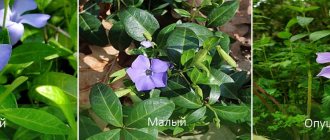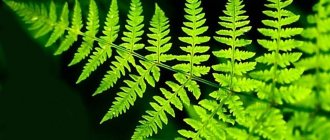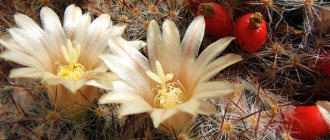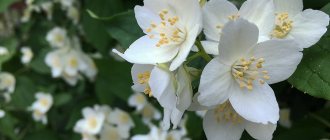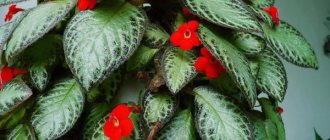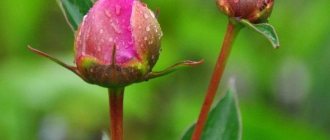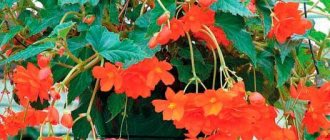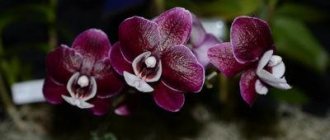- Deciduous begonia: types and varieties with photos and names
- Types of decorative deciduous begonias with photos and descriptions
- Decorative deciduous begonia: Mallet variety
- Decorative deciduous begonia: spotted or speckled variety (Maculata Raddi)
- Decorative deciduous begonia: coral variety (Corallina)
- Decorative deciduous begonia: Carolineifolia variety
- Decorative deciduous begonia: metal variety (Metallica)
- Decorative foliage begonia: variety credner or pig's ear (Credneri)
- Decorative deciduous begonia: variety Royal or Rex (Rex)
- Popular varieties and hybrids of royal begonia
- Decorative deciduous begonia: Mason variety or Maltese cross (Masoniana)
- Decorative foliage begonia: red-leaved variety (Erythrophylla or Feastii)
- Decorative deciduous begonia: hogweed variety (Heracleifolia)
- Decorative deciduous begonia: collar variety (Manicata)
- Decorative deciduous begonia: tiger variety
- Decorative deciduous begonia: Bower variety (Bowerae)
- Decorative deciduous begonia: bindweed variety (Convolvulacea)
- Ten best deciduous begonias: names and descriptions of species
- Types and varieties of decorative deciduous begonias for growing at home
- Video: review of varieties of decorative deciduous begonias
Deciduous begonia: types and varieties with photos and names
Decorative deciduous begonias have never been boring, but active selection and the emergence of ever new varieties have brought these plants to new heights. From indoor classics, magnificent and so special begonias have turned into modern and irreplaceable stars. Dazzling clouds of flowering varieties or the luxury of leafy patterns leave no one indifferent. And every year the range of begonias is growing, replenished with delightful fashionable new items.
Collection of deciduous begonias.
Decorative deciduous begonias usually grow in the form of a lush bush. The leaves are shaped like an asymmetrical heart. There are rounded leaves, carved leaves, and twisted leaves, with a jagged or wavy edge. The color of the leaf surface is very diverse: single-color, two-, three-, even four-color leaves combine shades of green, white, silver, burgundy and brown. There are leaves with a contrasting border and splashes of all shades. The leaf surface is decorated with pronounced veins. Such begonias can grow up to two meters in height or more, but have very small, inconspicuous flowers.
Pest and disease control
The set of typical begonia problems is standard for deciduous flowering plants.
— Excess moisture causes fungal diseases and powdery mildew. Check the core of the bush, usually the problem starts there. For treatment, remove all damaged fragments, reduce watering and treat the flower with antifungal drugs;
— The most common parasites are aphids and spider mites. To combat them, use classic insecticides;
Photo: outlawgarden.blogspot.com
— If the begonia does not bloom or the buds fall off, it is most likely cold, windy or lacking light. Try to change the place and not be overzealous with feeding;
— Yellowing leaves mean that the begonia does not have enough moisture or fertilizer. Sometimes this is a symptom of pests that are destroying the roots. Then you need to clean the rhizome, disinfect it with potassium permanganate and transplant the flower into new soil.
Photo: sup-kartoshka.ru
Types of decorative deciduous begonias with photos and descriptions
Begonia has quite complex classification systems that divide plant species and varieties into different groups. Some divide them by the method of use in floriculture, others by the type of root system or method of propagation. We decided to do something simpler and conditionally divide begonia varieties into decorative deciduous and decorative flowering .
Beautiful flowering begonias.
It is believed that the “evolution” of decorative flowering begonias is significantly inferior to decorative deciduous varieties. If in flowering indoor begonias they mainly change only color variations and improve endurance, then in the process of creating ever new varieties of deciduous beauties, breeders have long surpassed seemingly any expectations. Different textures, effects, colors, variations of patterns are complemented by the ability to choose the sizes and shapes of leaves. And sometimes it seems that new varieties appear every day.
On a note! Begonias can be selected not just according to your taste, but also for interior design, textiles and even accessories. And although the old varieties are still in demand, it is fashionable new items that have returned begonia to the peak of popularity.
Among decorative flowering begonias, the hybrid varieties of tuberous begonia (Begonia x tuberhybrida) can boast the greatest variability. Among them you can sometimes find the most unexpected color variations. But deciduous begonias are dominated by hybrids of Begonia rex, which in catalogs and at exhibitions often appear as varieties of unknown origin, in which purely decorative characteristics are considered the main ones.
Decorative begonia "Casey Corwin".
Decorative begonia "Casey Corwin".
Both begonias have something to look at. In this article we will introduce you to the most beautiful types of decorative deciduous begonias, leading in popularity ratings. They are valued for the unusual shape, texture and coloring of their leaves.
Begonia care
Begonia is quite unpretentious, but it needs stability. This is the only way the flower really reveals itself in all its glory. Flowering varieties can delight with a riot of colors throughout the year. And lush and lush deciduous species look luxurious in green corners.
Temperature
Begonia is a heat-loving plant. In summer, she feels best at a temperature of 20-23 degrees. In winter, do not allow hypothermia below 15-16.
Due to their love for tropical climates, flowers need moisture. But spraying the leaves is not recommended. This causes them to deteriorate and become stained.
Use an air humidifier or an additional tray filled with wet expanded clay. This way the begonia will have enough moisture and the root system will remain safe.
Photo: themarthablog.com
Lighting
The more sunlight, the better. Especially for brightly flowering species. But remember that begonia leaves are delicate. Shade them from too aggressive direct rays.
But deciduous varieties are not so demanding - diffused light from eastern or western windows is enough for them.
Photo: themarthablog.com
Watering
Begonia needs abundant watering. Especially in hot summer. But don’t let the water stagnate: more often is better, but less. Before watering again, wait until the top layer of soil dries out. Use only distilled water.
In winter, begonia is dormant, so watering is reduced. And tuberous varieties even go dormant. They need to be placed in peat and not touched at all.
Photo: felisov.ru
Fertilizers and fertilizing
Fertilizers need to be applied when the begonia has already bloomed. It takes a lot of resources to support such beauty. Use additives and admixtures once every 2 weeks after the first flowers appear. Just keep in mind that mixtures with nitrogen are only suitable for deciduous species.
Photo: 2sotki.ru
Trimming
To form a lush crown, begonia needs to be periodically pruned. Start at the young flower stage. Just periodically cut off the top, this stimulates the growth of side branches.
In the future, repeat the procedure as necessary. Trim only dry or overgrown stems. If you want, the begonia crown can be shaped - then pruning is done based on the desired result.
Photo: sdelai-lestnicu.ru
Decorative deciduous begonia: Mallet variety
The Mallet type includes decorative deciduous bushes with reedy stems and leaves of unusual texture, color and shape. Almost all of them are hybrids between cane begonias and begonias of other groups.
A typical representative of Mallet is the Arthur Mallet variety. This unpretentious plant has unusually beautiful leaves with a satin pink glow.
Begonia "Arthur Mallet".
Begonia "Spotted" or "Speckled".
Decorative deciduous begonia: spotted or speckled variety (Maculata Raddi)
This is a bush type of begonia, a herbaceous subshrub with an erect stem, which under favorable conditions reaches about a meter in length and width. Therefore, it is grown most often in greenhouses and winter gardens. It has elongated, asymmetrical leaves in the shape of a heart with an oblique center. Their length is 10-15 cm, width - about 5 cm. The tip is pointed. Visually, the leaves resemble angel wings in their shape. (For this similarity, our grandmothers called this begonia that way). The leaf plates are very dense and glossy. Their rich green background is literally dotted with silvery-white spots. The back side of the leaves has reddish-brown-red shades. The petioles are short, about 2 cm. The flowers are of unusual shape, white or light pink. They are formed on a drooping peduncle hanging down in small inflorescences from April to July.
Decorative deciduous begonia: coral variety (Corallina)
Previously, it was a separate species of begonia. Now they believe that this is a synonym for the “Spotted” begonia, i.e. its subspecies. This lush bush plant (over half a meter in height and width) has elongated-ovate leaves (up to 25 cm in length and up to 7 cm in width), with a serrated edge and a sharp tip. Their color is dark green, with white and silver inclusions in the form of spots or splashes. With the arrival of summer, a reddish tint appears on the back of the leaf. Flowering usually begins in spring. The buds are formed on the basis of fused petals of all shades of red, making the inflorescences look like luxurious berry clusters hanging down. The aroma of flowers is very subtle and refined.
Begonia "Coral" has its own popular varieties: " Lucerna " and " President Carnot ".
Begonia "Lucerna".
Begonia "President Carnot".
Begonia "Alfalfa" is a reed begonia. Its stems are straight, more than a meter in height. The leaves are large, oval-heart-shaped, with distinct veining and a coarsely toothed edge. The leaves are dark green with white or silver specks, stripes or spots. The reverse side of the leaves is red-brown. Flowering occurs from March to September.
This is a bush with shield-shaped leaf blades, dissected at the base, and with a slightly toothed edge. The leaves reach 30 cm in length and 15 cm in width. Their green leaf surface is decorated with whitish spots.
Decorative deciduous begonia: Carolineifolia variety
This begonia is one of the oldest domestic flowers. Her homeland is Mexico. The thickness of the creeping shoot is about 4 centimeters. Large palmately dissected leaf plates are placed on long, up to 40-45 cm, yellow-green petioles. The leaves do not exceed 35 cm in length. Their surface is covered with clearly visible veins. As the leaves age, they fall off, leaving marks in the form of scales on the stems. Pinkish or yellowish-green flowers are part of loose, brush-shaped inflorescences. Flowering begins in February.
Begonia "Carolinafolia". Begonia Metallica.
Planting and propagation
Begonia is propagated by all standard methods: division, cuttings and stems. But different species have their own nuances. Be sure to familiarize yourself with them in advance, otherwise the begonia will not bloom.
It's easiest with tuberous varieties. It is enough to trim, separate and replant the tubers in the sand mixture in February-May. Just keep in mind that they germinate and take root slowly. Any soil mixture for deciduous plants is suitable for planting begonias. She is not demanding in this matter. There is no need for regular transplantation. This must be done as the flower grows, so that the root system is comfortable in the flowerpot.
Photo: whiteflowerfarm.com
Photo: asienda.ru
Tradescantia (60 photos): types and features of care
Decorative deciduous begonia: metal variety (Metallica)
This is a subshrub with strong, erect, well-branched shoots. This type of begonia received its name due to the shade of the leaves: on the reverse side they are purple, but on the front side they are green with red veins and a metallic tint. The stems and leaves are entirely covered with short bristles. It blooms from spring all summer with small whitish flowers covered with pinkish hairs on the outside. Metallica does not tolerate either stagnation of moisture in the pot or drying out of the soil. It must be watered systematically, but moderately. We recommend growing it in bright, warm and cool rooms, hallways; it grows well even on the northern windows of cold greenhouses.
Where and how to plant?
There are certain planting rules that are recommended to be followed. To plant, the flowerpot needs to be 1/3 filled with drainage material, on top of which there should be a 2-3 centimeter layer of charcoal. Thanks to this, the roots do not rot.
After the begonia along with a lump of earth is placed in a pot, the rest of the space must be filled with soil and watered. Planting is carried out in March, after daylight hours become longer. Before this, tuberous begonias are germinated in boxes; there is no need to bury them in the substrate. They should be located in a bright place with an air humidity of 60-70% and a temperature of 16-18 °C.
Every year in the spring, the plant must be replanted in a pot, which should be 2 cm wider than the previous one.
Important! Bush begonia is one of the easiest to grow. The plant has a luxurious shape due to the fact that one bush can have up to 5 stems.
Lighting and location
The plant feels better in well-lit places, but not exposed to direct sunlight. Window sills facing west and east are suitable for this. In the fresh air, they are planted in a place where there is diffused light. Bush begonia does not tolerate when the direction of light changes, so it is not recommended to turn it.
Soil requirements
You can buy soil for a flower in a store or prepare it yourself. Pour a small layer of sand onto the bottom, then fill the pot halfway with leaf soil and add black soil and peat in equal proportions.
If the soil is prepared correctly, then bush begonia will grow well and bloom for a long time. The trunk will become strong, and the leaves will be healthy and juicy.
Decorative foliage begonia: variety credner or pig's ear (Credneri)
The variety was obtained by crossing Metallic begonia and Scarf begonia. The leaves are light green with a metallic sheen on top and bright pink underneath. In the light they shine through like the auricle. Bush type.
Royal Begonia or Rex. Begonia "Crednera" or "Pig's ear".
Photo
Bush begonia: photos of the most beautiful representatives of this species.
Here you can get acquainted with the bush variety of begonia Coral.
Decorative deciduous begonia: variety Royal or Rex (Rex)
This perennial herbaceous plant came to us from the tropical forests of Eastern India. Grows only indoors. This begonia is not tall, growing up to a maximum of half a meter in length. It has a thick creeping rhizome protruding above the soil surface. The stem is lodging, creeping, and eventually drooping (rhizome). Its leaves are large, broadly oval, very decorative. Their size reaches 30 cm. They have a heart shape at the base and sharp edges. There are other names - “Napoleon’s Ear”, “Elephant Ears”.
The color of the leaves, depending on the variety, can be dark green, bronze-brown with silver spots, or cherry red with a metallic sheen. The upper surface of the leaf is velvety, slightly pimply, covered with short hairs. On the reverse side it is cut with convex red veins. As a result of crossing with other species and varieties, unusual hybrids with spirally twisted or fringed leaves appeared. The plant is unpretentious in care. It blooms with such modest, inconspicuous flowers that they are removed. The variety of leaf shapes and their bright beauty more than make up for the lack of flowering.
Diseases of indoor begonia
Root rot . This disease of indoor begonias is caused by pathogenic fungi and in the vast majority of cases is the result of excessive watering. Signs of the disease are begonia stopping growth and dying leaves throughout the plant. You can accurately determine that a begonia has developed root rot only by removing it from the pot.
Affected roots are blackened, limp, and easily separated from the plant. If only part of the root system is affected, all diseased roots are removed, the root system is soaked in a fungicide solution: Vitaros, Oksihom, Alirin-B, Ordan (4), etc. Then the plant is transplanted into fresh soil.
If the begonia is severely damaged, it is unlikely that it will be possible to save it; you can try to root cuttings from it.
Gray rot . It primarily affects the above-ground part of the plant, and is especially dangerous when the begonia flower is kept in conditions of high temperature and humidity. Signs of gray rot are “watery” grayish spots on the leaves and petioles. Over time, the spots increase in size, become slimy, and parts of the plants die.
If gray rot is detected, all affected parts of the plant are immediately removed, the begonia is treated with copper-based fungicides: Khom, Oxychom, Bordeaux mixture 1% (4).
Powdery mildew. This begonia disease develops in high humidity and is most often introduced from other plants. A sign of the disease is a very characteristic powdery coating on the leaves and/or other parts of the plant.
To combat powdery mildew, use the copper-containing fungicides mentioned above or a solution of colloidal sulfur in a concentration of 0.3 - 0.5%.
Vascular bacteriosis . The disease manifests itself as yellowing and darkening of the leaves, starting from the edges. A very characteristic sign is the darkening and death of leaf veins.
In the early stages of the disease, the plant can be saved by removing the affected parts and treating the plant with fungicides. In case of severe damage, it is better to get rid of the diseased begonia.
Ring spot . A very dangerous disease of indoor begonia. Signs are yellow and brown round spots, often with areas of necrosis in the middle. The leaves may take on a reddish tint.
The disease is viral in nature, so there is no cure for it. You need to get rid of a diseased plant as soon as possible to avoid infecting the rest.
Popular varieties and hybrids of royal begonia
Begonia "Mini Merry Christmas" . This hybrid was bred in 1978. This is the most variegated variety of royal begonia. The average height of the bush is 30 cm. The top of the leaves is velvety, and the lower part is cut with large veins. The color changes from the center of the leaf to the edges. In the middle it is brown, then turns into red-crimson and becomes greenish-white at the edge with pearlescent splashes.
Begonia "Escargot" or king snail (Escargot).
Begonia "Mini Merry Christmas".
Begonia "Escargot" or royal snail (Escargot) is a low (up to 30 cm in height) and wide (up to 45 cm in width) decorative bush with large rounded leaves. It is distinguished by a two-color leaf color: the central part and edges of the leaf blades are painted brown-olive, and between them there is a wide stripe of silver color. The leaf surface is matte, it is covered with tiny burgundy hairs. At the base, the leaves are also twisted into a double spiral.
Begonia "Cartagena" (Cartagena) . It has oval leaf plates of dark green color, which are wrapped in a shell. The center of the leaf is dark brown, but becomes plum-colored as it ages. Silvery spots are scattered on the green background of the leaf plate, which are sometimes illuminated with a light pink glow.
Begonia "Cartagena".
Begonia “Chocolate Cream”.
Begonia “Chocolate Cream”. This variety of begonia is distinguished by a large leaf with a spiral-twisted base. The central part of the leaf plate is painted a rich plum color. The veins and fringed edge are a vibrant dark brown. Most of the leaf glows with a silvery-pink tint. Beautiful!
Begonia "Silver Greenheart". It has large silvery leaves with an oblique heart-shaped shape. The edges of the leaves are decorated with a wide border of emerald green, dotted with silver spots.
Begonia "Silver Greenheart". Begonia 'Evening Glow'.
Begonia 'Evening Glow'. This hybrid has medium-sized leaf blades. Their central part has a rich crimson color, from which brownish-green veins radiate. Brownish-green veins radiate from the center along part of the crimson-colored leaf. There is a crimson border along the edge.
Begonia "Dollar Down". The compact bush has a height of 25-30 cm. Its cherry-red leaves are decorated with a dark border. The shape of the leaf plate is fan-shaped, spiral-shaped, its size increases from the middle to the edges.
Begonia "Pearle de Paris" (Pearle de Paris). Well branched bush. It is characterized by medium-sized leaves of gray-silver color with dark, clearly visible veins.
Begonia "Pearle de Paris" (Pearle de Paris).
Begonia 'Regal Minuet'.
Begonia 'Regal Minuet' . An instance of this variety is a small bush with paper-thin leaves that turn bright burgundy in good light. In low light, the color changes noticeably and becomes silvery-pink. At the same time, the border and center of the leaf plate are painted brown.
Begonia "Grifon" (Grifon) . This strong and durable begonia bush reaches a height of 40 cm. Its leaves are large, lush, shaped like the open paw of a griffin, dark green in color with a silver pattern. They are located on long petioles.
Begonia "Griffin" (Grifon).
Begonia "Lilian".
Begonia "Lilian". has large leaves of emerald green color, covered with silvery peas, turning pink at the base. The border is wide, burgundy-brown. The leaves at the base are twisted into a double spiral.
Begonia "Black Mamba" (Dark Mamba) . It differs in the way the leaf blades grow - it is spiral-shaped. The color of the leaves is also impressive - the deep dark green color appears completely black, and the reverse side of the leaves is cherry brown.
Begonia "Black Mamba" (Dark Mamba).
Begonia "November Frost".
Begonia "November Frost " The bush is small. The leaves are similar to maple, twisted into a spiral at the base. The main color of the leaf is silver, and the central part, numerous small veins and the border along the edge are dark brown.
Begonia "Black Fang". This is an amazingly beautiful variety of begonia. Its leaves are twisted into a double spiral. They are velvety, black-olive in color with thin lemon veins. The underside of the leaf is bright crimson. The bush is compact. Requires good lighting.
Begonia "Black Fang".
Begonia "Black Prince"
Begonia "Black Prince" Dark, almost black velvety leaves with carved, coarse-toothed edges, the underside of the leaf is red-brown.
Begonia "Hallelujah" This hybrid has large, spirally twisted purple leaves with a silver coating at the petioles. The central part and edge of the leaves are cherry-colored, and between them there is a fairly wide strip of rich green color with numerous silver spots.
Begonia "Hallelujah" Begonia "Mason".
Pests of indoor begonia
Aphid. These are very small, wingless, greenish insects that can be detected with the naked eye. Signs of pest damage to begonias are paleness and dying of leaves.
The most convenient way to combat aphids is with the help of a special green soap; in extreme cases, you can use laundry soap. Sometimes tobacco infusion is used at home. Among agrochemical agents against aphids, Actellik or Fitoverm are used (4).
Whitefly . A winged insect of a whitish color with a body length of up to 2 mm. Signs of infestation are the same as for aphids.
The means of control are similar: washing the plant with green soap (2 - 3 times at intervals of several days) or insecticidal preparations: Actellik, Fitoverm (4).
Spider mite. The most common pest of begonias and other indoor plants, manifesting itself as weakening leaves and a characteristic cobwebby coating on different parts of the plant.
For spider mites, the same remedies are used as for aphids and whiteflies; Kleschevit has proven itself well (4).
False shield . Large pests of begonias, up to 4 mm in size, are easily identified as brown “shield” growths attached to the leaves, most often on the reverse side.
Begonias with dense, few leaves can be removed from scale insects mechanically: the plant is washed with green soap, removing scale insects with a soft toothbrush. If the lesion is severe or begonia with delicate foliage is infected, the plant must be treated with Actellik or Aktara (4) according to the instructions.
Thrips . A dangerous pest of indoor begonias and other plants is a winged insect up to 2 mm long. Adults are black or dark brown, larvae are orange.
For thrips, use the same remedies as for false scale insects, and be sure to treat the soil in the pot. In case of severe thrips infestation, it makes sense to transplant the begonia into fresh soil.
Decorative foliage begonia: red-leaved variety (Erythrophylla or Feastii)
Begonia Redleaf. This plant has another name among gardeners - “Pista”. It has a slightly shortened stem, erect, with nodes. Long cuttings and whole or cut into several segments round leaves, the surface of which is dense, smooth, almost glossy. The front side of the leaves is green, and the back side is red, brownish or purple with well-drawn white veins. The edge of the leaf is jagged or wavy. Flowering occurs from December until spring. The color of the flowers is white, pink, yellow, red with frames of various shades.
Begonia Redleaf. Begonia "Horseweed".
Why doesn't begonia bloom?
This question will never arise for a gardener who follows all the rules described above. If all the conditions are created for begonia: diffused light, watering without waterlogging and drying out the roots, the right temperature, regular feeding, then it will bloom exactly as much and even longer than the variety should. That is, evergreens are decorated with flowers all year round, Elatior - in winter, all other varieties begin to bloom in spring throughout the summer.
If only one nuance. Begonias are not long-lived, they delight with beautiful foliage and abundant flowering for only 2-3 years, and then you need to take a cutting or a leaf and plant a new begonia . The old one will no longer grow or bloom.
Decorative deciduous begonia: hogweed variety (Heracleifolia)
Begonia "Horseweed". This plant is native to Brazil. It got its name due to its resemblance to the leaves of the Hogweed plant, common at that time. Now this begonia is a very popular plant in home gardening. It has thick, green or cherry-brown stems with long, dense fibers. It is distinguished by its asymmetrical leaf blades - they are large (in nature up to 30 cm), palmately dissected, with sharp serrated edges and a heart-shaped base. The leaves are colored in green, cherry-red or red-brown tones, and the saturation directly depends on the level of illumination. Silver-gray veins are relatively evenly distributed over the entire surface of the leaf. The peduncles are long, the inflorescences are enlarged with small, inconspicuous light pink flowers of irregular shape.
Planting in open ground
The exotic, whose homeland is equatorial countries, will not survive the harsh Russian winter. Therefore, the flowerbed will have to be updated every year . But what an opportunity to see a variety of varieties of evergreen begonia!
Deadlines
Already grown seedlings are planted in the ground . The optimal planting time will be mid-May, when the soil has already warmed up sufficiently and the threat of recurrent night frosts has completely passed.
Selecting a location
In order for semperflorence to bloom profusely and beautifully all summer, attracting attention, you need to choose the right place on the site .
Attention! Although the everblooming begonia is native to the warmer regions of America, direct sunlight falling on the flower all day can cause burns on the delicate leaves.
You should not plant seedlings in dense shade either: such conditions will cause the sprouts to stretch out, and the flowering will be faded and indistinct.
Give preference to areas where the bright sun will illuminate the plantings before noon and after five o'clock in the evening , and in the midday heat they will be shaded.
Soil preparation
Begonia prefers loose, nutritious soil . Before planting seedlings in the ground, it is important to disinfect the soil by spilling it with a solution of potassium permanganate.
Attention! Be sure to lay a drainage layer before planting flowers. Prolonged contact of roots with moisture will lead to plant rotting.
If the soil on the site is too heavy and lumpy, it should be loosened by adding peat and calcined river sand.
Landing
Thanks to the variety of colors and sizes of plants, gardeners create incredible compositions in flower beds of ever-flowering begonias.
Prepare holes for planting seedlings:
- Pebbles or crushed bricks are placed at the bottom of each to ensure good drainage.
- It is good to add a layer of rotted compost on top: this will provide the flowers with nutrients.
- The holes are dug at a distance of at least 10 cm from each other so as not to thicken the plantings.
- The sprouts should fit freely in the hole so that the roots can be easily straightened.
- There is no need to deepen the plant too much; the root collar should be above the surface of the ground.
Decorative deciduous begonia: collar variety (Manicata)
Begonia "Collar" . This is a very unpretentious variety for home cultivation. The bush is quite large and spreading. It has large light green leaves, the diameter of which reaches 30 cm. Their upper part is glossy, and the lower part is covered with “cilia”. The edges of the leaf blades are cut and covered with small fibers. This begonia got its name because at the place where the cuttings are attached to the leaf, a kind of “cuff” is formed from red hairs.
Begonia "Collar".
Begonia "Tiger".
Varieties of evergreen begonia
Semperflorence is divided into three groups according to the height of its shoots.
Tall
The height of such plants is about 0.4 m and above . Tall begonias are distinguished by large leaf blades and equally large flower cups (some fully opened buds can reach 60 mm in diameter).
Medium height
Medium-sized plants include bushes whose height does not exceed 0.3 m . The size of the leaf blades of such bushes is noticeably smaller than that of tall varieties, and the flowers are smaller.
Low-growing or dwarf varieties
The height of such bushes does not reach 0.2 m . The leaves and flowers are quite small, but such flowers have a higher adaptive capacity than their taller counterparts.
Dwarf begonias look great both in open ground and in flowerpots and pots.
Decorative deciduous begonia: tiger variety
Begonia "Tiger" . This species is native to Mexico. It has gained popularity due to the exquisite beauty of the leaves, the compact shape of the bush and its ease of care. Small white flowers appear in winter, but gardeners usually remove them so that they do not take away the strength of the begonia and the nutrition of the leaves. (Do the same with old leaves). The tiger begonia has virtually no above-ground stem; long drooping leaves grow directly from the root system. The bush reaches only 30 cm in height. The color of the leaves is remarkable: green, with spots of light green, brown or black. The reverse side of the leaves is pubescent. This species is rarely found in nature. But flower growers are happy to grow many of its hybrids indoors. Tiger begonia is unpretentious and grows well in shade and partial shade.
Benefits of the plant
- Begonias bloom profusely throughout the summer until the first frost.
- Grows well in sun and partial shade.
- The choice between the available varieties is so great that you can choose between many interesting flower colors and different shapes, reaching from 10 to 30-35 cm in height, with straight or drooping stems.
- The flower can be grown in flower beds, in pots, containers, decorating terraces and balconies.
- Ready-made seedlings are widely available for sale in the spring.
- Young plants can be grown without problems at home on a windowsill by planting tubers bought in a store or stored from the previous season in early spring.
Decorative deciduous begonia: Bower variety (Bowerae)
Begonia "Bauer" (Bowerae) . It is a hybrid of tiger begonia. This is a small indoor plant, up to 15 cm high. It has heart-shaped, velvety leaves with rounded edges, an unusual tiger color: light green, bronze-tinged spots stand out sharply against a dark, almost black background. The edges of the leaves are framed with milky white cilia, and the veins stand out very clearly. The leaves are attached to long red cuttings. Peduncles appear in spring directly from the rhizome (creeping), on which basal rosettes are formed. The flowers are collected in brushes - umbrellas. Bauer's Begonia also has its own hybrids: Black Velvet Begonia. Grows in the form of a bush. Its stem is creeping, spreading along the surface of the soil. Star shaped leaves. They are dark chocolate, almost black, with velvety edges. The petioles are covered with light hair. It blooms with inconspicuous whitish flowers, which, surprisingly, look fascinating on the black velvet of the leaves.
Begonia "Bauerae" Begonia “Black Velvet”.
Begonia “Cleopatra” (American Maple, Boveri, Maple-leaved) . This begonia reaches a height of 50 cm. It has a thin, erect, branching stem covered with hairs. The species is valued for its unique leaves. They are large, olive-colored on top with white veins, and red-burgundy on the back. The leaf blades are finger-shaped and covered with small light hairs. During flowering, a tall peduncle appears on the bush, in the lower part of which small inflorescences of white and pale pink color with a yellow center are formed.
Begonia “Cleopatra” (American Maple, Boveri, Maple-leaved).
Begonia "Convolvulus".
Decorative deciduous begonia: bindweed variety (Convolvulacea)
Begonia "Convolvulus" . Such begonias seem to be created for arches, all kinds of openings and stairs. Balcony grilles can also be used as a support, which in one summer season will turn into delightful flower walls, delighting the eyes of owners and passers-by on the street.
However, climbing begonias are afraid of direct sunlight, so they should be placed on the north-eastern or north-western side of the house or in the shade of other plants. The leaves form a lush bush about 20-30 cm high, although if comfortable living conditions are maintained, the plant can grow up to 50 cm. The flowers are small and inexpressive.
Ten best deciduous begonias: names and descriptions of species
The Jurassic Watermelon variety of Begonia rex looks like a bizarre creation from among the ancient relics. The combination of unique shades of color and patterns, shape and pattern on the leaves make this begonia not just original, but unique. The large snail at the base of the leaves seems to flow into the “tail” - the elongated tip of the leaf, somewhat reminiscent of a reptile’s tail. The color only emphasizes this effect: the watermelon-pink spot in the center almost exactly repeats the shape of the leaf and, as it were, brings the illusion to perfection. Under the pink spot and against the bright green background of the rest of the leaf blade, silver-white drops are visible, which seem to be frozen paint or dew drops and literally glow. But this is not all the surprises of this begonia: a densely ruffled carved edge with a unique blueberry-lilac color is combined with a dark, unevenly diverging veined spot at the center of the cochlea. Begonia leaves bloom so thickly that the petioles and stems are almost impossible to see. This is a fairly large bush, even at a young age it seems massive.
Decorative begonia "Jurassic Watermelon". Begonia decorative-lithic "Shamus".
The 'Shamus' variety is a rex variety with a classic combination of vibrant greens and purples, but still manages to look irresistibly original. It's all about the motley ripple patterns and deeply dissected leaves, the shape of which is difficult to discern behind the play of contrasting patterns. The begonia bushes themselves, although medium in size, look very impressive, almost spherical due to the tiered arrangement of the leaves. The leaf is spiral-shaped, with an arched notch at the base, bright green, the veins are light. The ripple effect on begonia leaves creates a lacy, chaotic pattern of almost black spots located parallel to the edges of the leaf and creating an ornamental effect.
The Talking Bird variety is a unique medium-sized variety of begonia that seems to shine no less than precious orchids. The leaves are elongated and medium-sized, but thanks to the strong bushiness, the plant seems very lush. The smooth edge with neat teeth emphasizes the play of colors. The leaves of this white and pink beauty seem pearlescent and literally shine. This effect is achieved thanks not only to the white-silver color of the begonia leaf blades, but also to the chaotic, cobweb-like patterns: cherry and pink veins diverge along the veins in small strokes, like lace, forming an amazing texture.
Begonia variety “Talker Bird”. Begonia variety "Casey Corwin".
Begonia 'Casey Corwin' , a magnificent variety of Begonia rex, appears regal and almost artificial. In favorable conditions, this variety has practically no green color, and the play of shape, color and details turns the leaf into a small living jewel. Oval, with a strongly elongated tip, the medium-sized leaves of this variety are distinguished by a weakly expressed snail at the base of the begonia leaf and a strongly jagged, asymmetrical edge, giving the plant a lace-like appearance. The carved edge is perfectly emphasized by the play of colors. Silvery, almost white velvet spots most often cover the entire surface, combined with a beet-raspberry heart spot in the middle of the leaf, with slightly darker thin veins and the same beet-like, uneven, but very thin border, which seems to highlight the teeth on the edge. Red pubescent cuttings of begonia only emphasize the play of silver and beetroot tones. And in terms of the density and lushness of the bushes, this variety is also inimitable.
The begonia variety "Garden Angel Blush" has deeply dissected leaves that truly resemble the wings of angels. If in the previous variety the presence of green in color directly depends on the growth conditions and, although still rare, occurs, then this begonia is visually devoid of it. This is a silver-pink miracle, airy, lacy and inimitably spectacular. The shape of the leaves is somewhat reminiscent of maples, due to the deep dissection of the leaf blade and the pointed tips of the lobes. The leaves' dark green or dark purple veins, reminiscent of vessels, emphasize their unusualness even more. Young bright pink begonia leaves fade over time and turn into living silver, and the color transformation is heterogeneous and no less beautiful than both basic color options. These plants are large, catchy, voluminous.
Begonia begonia "Garden Angel Blush".
Decorative begonia "Peter Piper".
The Peter Piper variety is a variety that from afar can be mistaken for a bouquet of dry autumn leaves. The thing is that among indoor decorative deciduous begonias you can no longer find varieties with such a wealth of orange-red-brown shades. This is a compact variety with rounded, kidney-shaped leaves, with a strongly wavy surface and “soft” teeth along the edge. The reverse scarlet-purple side of the leaves is visible on the bends, further emphasizing the color of the upper side of the leaf blades. Brick orange, terracotta, different shades of brown watercolor spread across the begonia's leaf blade, highlighted only by slightly darker reddish veins. Usually, a light yellow spot is found at the very base of the leaf, near the stalk. The silvery, luminous edge makes all shades of color shine in a new way.
The “Dress Code” variety is an exclusive and still rare, but surprisingly pure begonia variety in both leaf shape and color. Few plants come so close to the monochrome color of the leaves than this beauty. Medium-sized begonia captivates not with its quantity, but with the beauty of its large, ideal oval-shaped leaves with a slightly pointed tip and an almost solid edge. The leaves are light, almost white, as if sprinkled with light powder. The strict inky black border and dark spot in the center of the begonia leaf contrast stunningly with the base color. The powdery effect is enhanced by small light peas along the border, which can only be appreciated up close. This is an unusually catchy variety that looks very modern.
Begonia decorative-lithic “Dress Code”.
Begonia decorative-lithic “Black Swan”.
The variety “Black Swan” is a unique hybrid of begonias, even compared to other varieties that are almost black in color. It's all about the large leaves of an unusual shape, which bend and bend, reminiscent of the silhouettes of these graceful birds. Despite the very large leaves, this begonia's bushes are not large. They are graceful and elegantly unusual. The smooth edge of the foliage is compensated by the waviness and curvature of the leaf plate. Bright red cuttings wonderfully emphasize the beauty of the glossy inky-reddish color, and translucent silver spots, unevenly scattered between the veins, emphasize the tint of tone and make the leaves more noble. This is a light-loving variety whose leaves are not similar to any other begonia.
The White Suede variety has leaves only slightly darker (light pistachio, almost whitish), but the character of this begonia is completely different. A medium-sized begonia produces not so large leaves with an inconspicuous snail at the base. The shiny, suede-like leaves of the begonia appear delicate. And this effect is only emphasized by the white veins, which can only be seen close up, as well as the chaotic, all consisting of small dark red strokes and specks, openwork border along the edge of the sheet. In the center, dark spots of a dark marsh color also diverge unevenly along the veins.
Begonia decorative lithium “White Suede”. Decorative begonia “Purple Snow”.
The “Purple Snow” variety is another begonia variety with very large leaves that evoke associations with either maples or chestnuts. This large plant has become famous for its very modest bush size: the plant does not produce many leaves and still remains graceful. Each leaf is round, with a beautiful serrated edge, shallow dissection into lobes and a wavy surface. The large size of the leaf is emphasized by a double snail at the base. The silvery-green color is combined with burgundy veins and the edge of the leaf, and the spots look like “sprinkles” and consist of the finest fragments. This begonia really looks like it has been sprinkled with burgundy snow and is one of the most regal varieties of decorative deciduous begonias.
Types and varieties of decorative deciduous begonias for growing at home
Begonia Curly Fireflush.
Begonia Dollar Down.
Begonia Escargot.
Begonia Garden Angel Silver.
Begonia Green Silver.
Begonia Harmony's Red Robin.
Begonia Jolly Holly. Begonia Jurassic Rex. Begonia Montgomery.
Begonia Looking Glass.
Begonia Midnight Sun. Begonia Raspberry Swirl.
Begonia Silver Bells. Begonia Silver Dollar.
Begonia Silver Jewel. Begonia Silver Leaves.
Begonia Silver Spirit.
Begonia Silver Spirit. Begonia Specter Silver.
Begonia diadema.
The variety of species and varieties of begonia can amaze any gardener - both beginners and quite experienced ones. We introduced you to only one group of these amazing flowers - the decorative deciduous species of begonia. All of them are easy to care for, stunningly beautiful all year round, easy to reproduce and have a lot of useful properties. For now, choose and purchase the varieties you like, and we will write in the next article how to care for them indoors.


